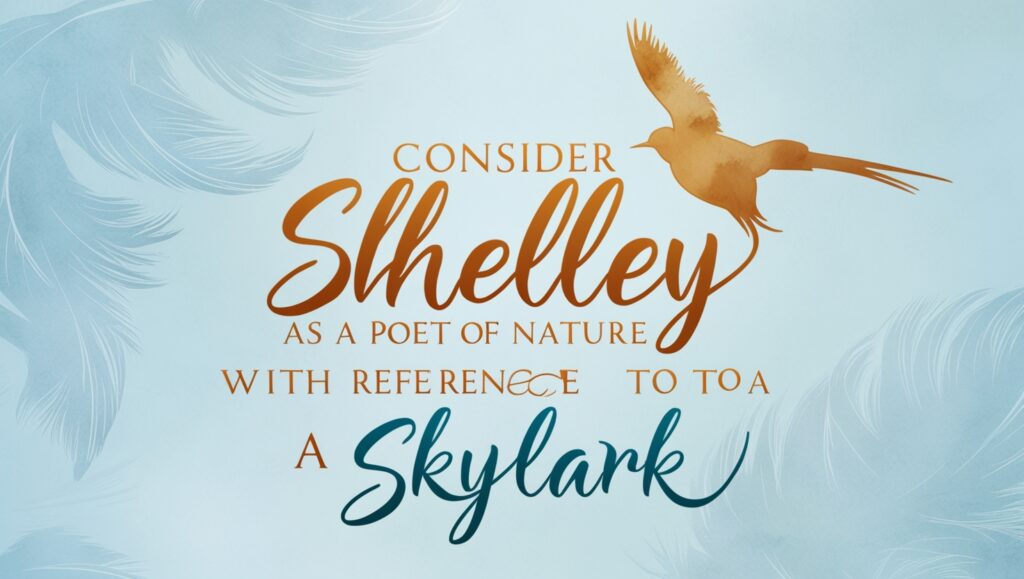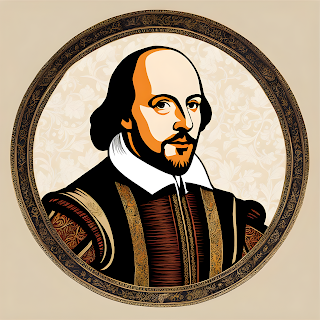
Consider Shelley as a Poet of Nature with Reference to To a Skylark
Percy Bysshe Shelley, one of the major figures of the Romantic movement, is often hailed as a poet of nature for his profound engagement with the natural world and his use of nature as a vehicle for exploring philosophical, spiritual, and emotional themes. In many of his works, Shelley treats nature not merely as a backdrop for human activity but as a dynamic, living force imbued with deep significance. His poetry often reflects the belief that nature is a source of inspiration, wisdom, and transcendence, offering insight into the mysteries of existence. To a Skylark is a prime example of Shelley’s treatment of nature, in which the skylark becomes a symbol of ideal beauty, joy, and artistic inspiration.
In this analysis, we will examine Shelley as a poet of nature with reference to To a Skylark, focusing on his portrayal of the skylark, his use of natural imagery, and the philosophical ideas that arise from his engagement with the natural world.
The Skylark as a Symbol of Nature’s Transcendence
Shelley’s To a Skylark begins with an invocation of the skylark as a “blithe Spirit,” a phrase that immediately sets the bird apart from the mundane, physical world. The skylark, in Shelley’s portrayal, is not just a bird but a symbol of nature’s transcendence—a creature that exists beyond the limitations of the material world and embodies a higher state of being. Shelley writes:
“Hail to thee, blithe Spirit!
Bird thou never wert—”
By describing the skylark as a “Spirit” rather than a mere bird, Shelley imbues the creature with a sense of ethereality and otherworldliness. The skylark becomes a symbol of freedom and joy, soaring high above the earth and expressing a form of beauty that is untethered from the sorrows and limitations of human life. In this way, Shelley elevates the skylark to the realm of the sublime, where nature is not just a passive presence but an active force that reveals deeper truths about existence.
The skylark’s flight, which carries it higher and higher into the sky, becomes a metaphor for transcendence—an escape from the confines of earthly existence into a realm of pure joy and inspiration. The bird’s song, which continues even after the bird itself has disappeared from sight, reinforces the idea that nature has a power and significance beyond what is immediately visible or comprehensible to humans. Shelley’s portrayal of the skylark thus reflects his belief that nature possesses a spiritual dimension that can inspire and elevate the human soul.
Natural Imagery and Metaphor
As a poet of nature, Shelley frequently uses vivid imagery and metaphor to connect the natural world to broader philosophical and emotional themes. In To a Skylark, he draws on a wide range of natural images to describe the skylark’s beauty and its song, creating a rich tapestry of visual and auditory impressions that highlight the bird’s connection to the larger forces of nature.
For example, Shelley compares the skylark to a “cloud of fire” that rises into the sky at sunset:
“Like a cloud of fire;
The blue deep thou wingest,
And singing still dost soar, and soaring ever singest.”
The image of a “cloud of fire” suggests both the ethereal beauty of the bird’s flight and its radiant, transcendent nature. The comparison to fire also evokes the idea of transformation, as fire is a symbol of both destruction and creation. In this context, the skylark becomes a metaphor for the transformative power of nature, which has the ability to inspire and uplift the human spirit.
Shelley also uses images of flowers, light, and water to convey the beauty and mystery of the skylark’s song. He writes:
“Like a rose embowered
In its own green leaves,
By warm winds deflowered,
Till the scent it gives
Makes faint with too much sweet these heavy-winged thieves.”
The comparison of the skylark to a rose hidden in its leaves suggests a sense of hidden beauty and fragility, while the image of “warm winds” scattering the flower’s scent evokes the idea of natural forces that are both gentle and powerful. The skylark’s song, like the scent of the rose, is delicate yet pervasive, spreading joy and beauty through the air.
Through these natural metaphors, Shelley emphasizes the idea that nature is not only beautiful but also mysterious and awe-inspiring. The skylark’s song, like the scent of a rose or the light of a fire, is something that can be experienced but not fully understood, reflecting the Romantic belief in the sublime power of nature.
Nature as a Source of Inspiration
In To a Skylark, Shelley presents nature as a source of artistic and creative inspiration, a theme that is central to his broader poetic philosophy. The skylark’s song, which is described as “profuse strains of unpremeditated art,” becomes a metaphor for the ideal form of artistic expression—spontaneous, joyful, and free from the constraints of human thought and labor. Shelley contrasts the skylark’s effortless song with the struggles of human creativity, suggesting that nature possesses a kind of wisdom and beauty that humans can only aspire to.
The skylark’s song is described as a form of pure, unmediated joy:
“In the golden lightning
Of the sunken sun,
O’er which clouds are bright’ning,
Thou dost float and run,
Like an unbodied joy whose race is just begun.”
Here, the skylark’s song is likened to “unbodied joy,” suggesting that it is an expression of something beyond the physical world—an ideal of pure happiness and beauty that transcends the limitations of human experience. This portrayal of the skylark as a source of artistic inspiration reflects Shelley’s Romantic belief that nature is a guide and teacher for the poet, offering access to higher truths that cannot be found in the human world.
At the same time, Shelley acknowledges the limitations of human understanding. While the poet longs to capture the skylark’s joy and spontaneity in his own art, he recognizes that human creativity is always tinged with sorrow and imperfection:
“We look before and after,
And pine for what is not:
Our sincerest laughter
With some pain is fraught;
Our sweetest songs are those that tell of saddest thought.”
In these lines, Shelley contrasts the skylark’s untroubled joy with the complexities of human emotion, suggesting that even in our moments of greatest happiness, we are always aware of the possibility of loss or sorrow. This tension between the perfection of nature and the imperfection of human life is a central theme in Shelley’s poetry, and it reflects his belief that while nature can inspire and uplift the human soul, it also reminds us of our limitations.
Philosophical Engagement with Nature
Shelley’s engagement with nature in To a Skylark goes beyond simple admiration or description; it is deeply philosophical, reflecting his Romantic belief in the interconnectedness of nature, art, and the human spirit. For Shelley, nature is not just a source of beauty but also a means of exploring existential questions about joy, creativity, and the nature of existence.
The skylark’s song, which rises “higher still and higher” into the sky, becomes a symbol of the human desire for transcendence—a longing to rise above the limitations of earthly life and experience something greater. Yet Shelley is keenly aware that this ideal state is beyond human reach. The skylark, as a creature of nature, embodies the possibility of transcendence, but it remains ultimately inaccessible to the human speaker.
In the final stanzas of the poem, Shelley expresses his desire to learn from the skylark, to capture some of its joy and inspiration in his own poetry:
“Teach me half the gladness
That thy brain must know,
Such harmonious madness
From my lips would flow,
The world should listen then, as I am listening now.”
This plea reflects Shelley’s view of nature as a source of wisdom and insight, capable of teaching the poet how to transcend the limitations of human life. However, the speaker’s use of the word “madness” also suggests that such joy and freedom may be beyond human comprehension, reinforcing the idea that nature possesses a power and mystery that we can never fully understand.
Conclusion
In To a Skylark, Shelley reveals himself as a poet of nature, using the skylark as a symbol of the sublime beauty, joy, and inspiration that nature offers. Through vivid imagery, metaphor, and philosophical reflection, Shelley explores the transcendent power of nature and its ability to elevate the human spirit.
The skylark becomes more than just a bird in Shelley’s poem; it is a representation of the ideal state of existence, free from the sorrows and limitations that define human life. At the same time, Shelley acknowledges the distance between this ideal and the reality of human experience, using the skylark to reflect on the tension between aspiration and limitation.
Ultimately, To a Skylark is a profound meditation on the role of nature in human life, art, and philosophy, and it showcases Shelley’s unique ability to blend emotional intensity with intellectual depth. As a poet of nature, Shelley’s vision extends beyond the physical world, engaging with the mysteries and wonders of existence in a way that continues to resonate with readers today.

